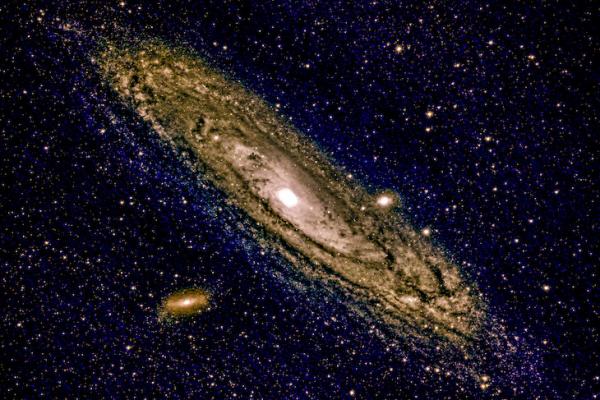By Stargazer Ron
If one stays up late, it could be worthwhile to visit a dark location around midnight and look straight up a bit to the east. Those with 20/20 vision might be able to see a faint blob. That would be M31, better known as the Andromeda Galaxy — the most distant object that is knowingly visible with an unaided eye. It is thought to contain a trillion suns and resembles our own Milky Way Galaxy. The two of them are part of our Local Group, being “only” 13 million trillion miles from each other. There are probably 2 trillion galaxies in that universe and about 200 billion trillion stars. That is much more than the estimated 8 million trillion grains of sand on earth. Now you know why Carl Sagan wrote a book titled “Billions and Billions.” I can only hope I’ve got my superlative numbers right.
Here is Andromeda as observed from my backyard between Santa Barbara and Goleta. I made this photo on September 25, just after midnight using a digital camera with a 500mm telephoto lens mounted on a star tracker that rotated once every 24 hours. That way I could use a long exposure time of 44 minutes. In this image we can imagine what our Milky Way looks like: a central bulge with a nucleus containing a black hole, then a disk with spiral arms having dark areas containing dust and other dark matter. The Milky Way’s diameter is about 600,000 trillion miles and our solar system is 144,000 trillion miles out from the center. The color changes from thick yellows in most of the galaxy to thinner blues along its perimeter. This reflects stellar ages ranging from old cool yellow stars to young hot blue ones that were being born.
M31 is expected to collide with the Milky Way in about 4 billion years. Such events are common among the galaxies within local groups. The fate of the earth and the solar system when that happens is unknown but, given the extreme distances between stars, they are likely to survive the collision if they still exist at that time. Note the smaller satellite galaxy below Andromeda. It is M110, a dwarf elliptical galaxy that is also in the Local Group.
That’s enough billions and trillions for now!







